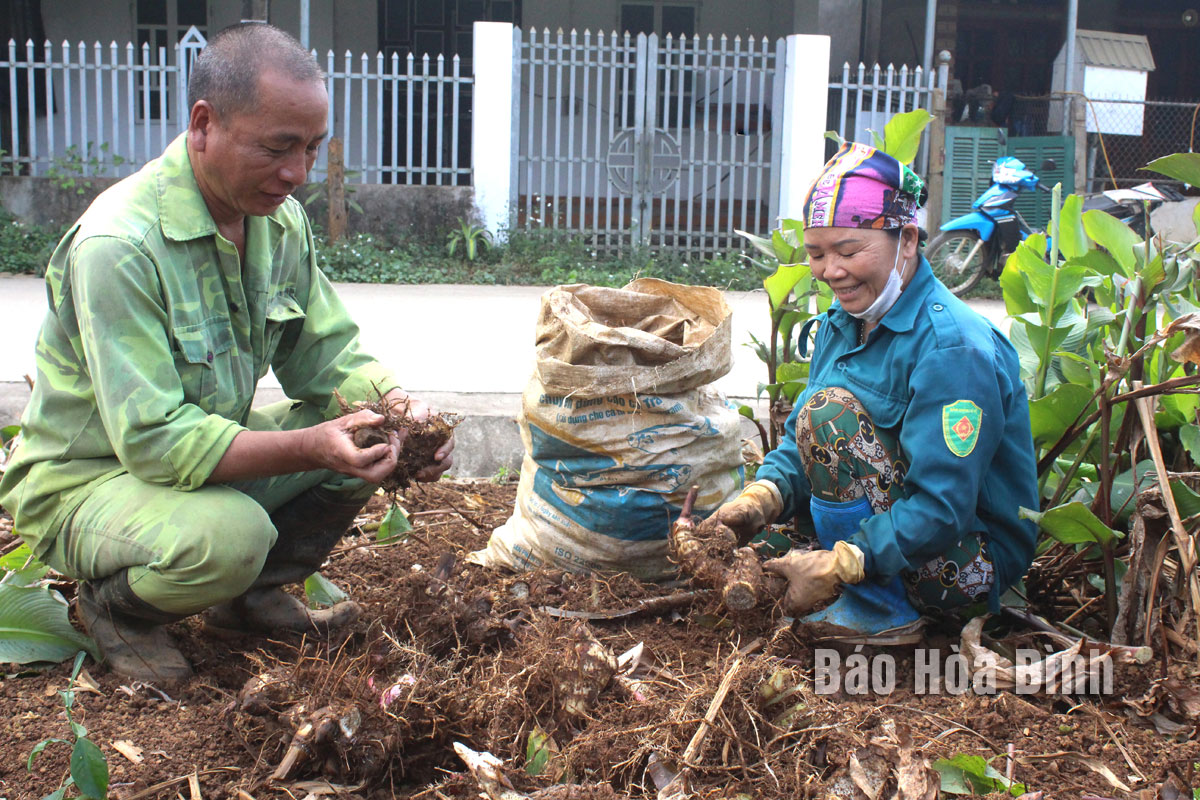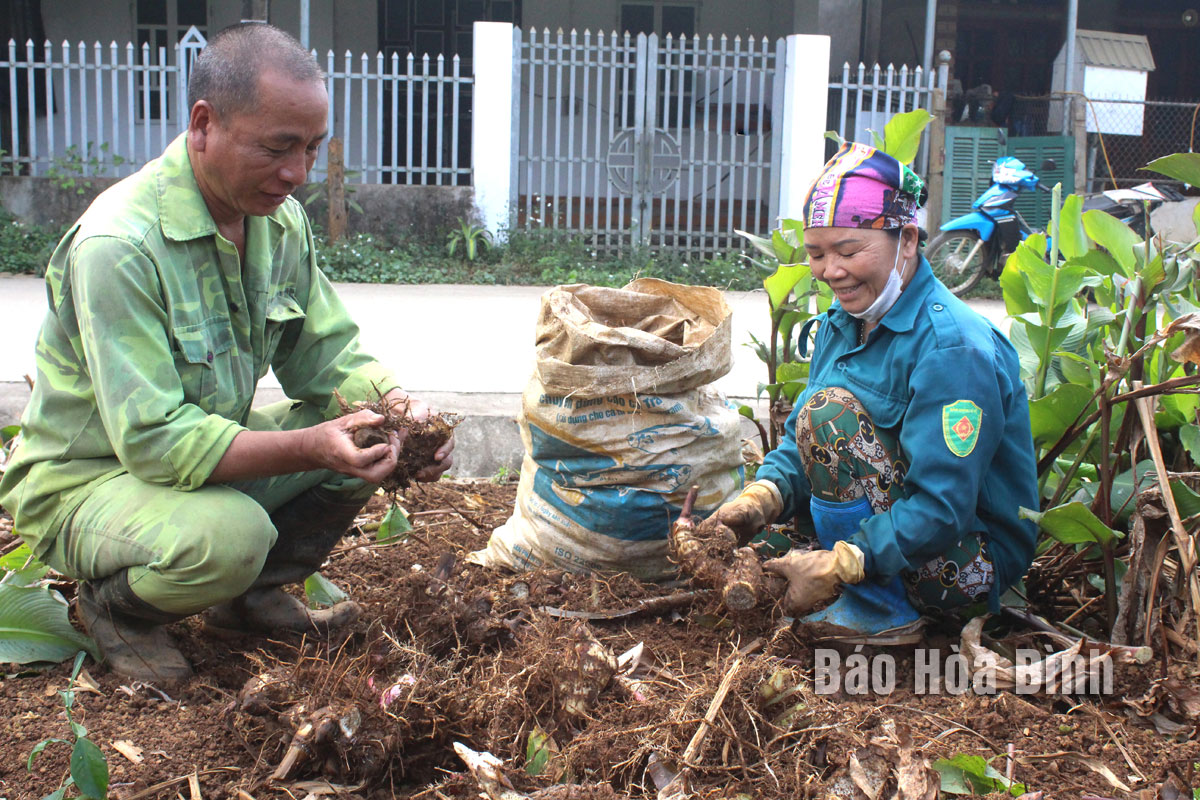
These days, the people in Cao Son commune (Da Bac) are busy harvesting arrowroot. The price of arrowroot purchased by traders is 17 thousand VND/10 kg, nearly double that of the last year's crop.
This year, the people in Cao Son commune (Da Bac) are excited because the price of arrowroot is high.
The arrowroot tree has been attached to Cao Son fields for a long time, and it is considered one of the key crops in hunger eradication and poverty reduction in the commune. However, the output of the product is unstable, there are still years when the harvest is good and the price drops, causing people to lose money. This year's arrowroot crop brings joy to the farmers, as the purchasing price is quite high.
Mr. Nguyen Van Tuan's family in Seo hamlet has been growing arrowroot for many years, with an average annual output of 25 - 30 tons. Taking advantage of the favorable weather, Mr. Tuan and his family focused on harvesting arrowroot to sell. Mr. Tuan says that in 1985, his family settled in Cao Son. Since 1990, they have maintained growing arrowroot almost every year. This plant is suitable for the soil so the yield and quality are stable. This is the crop that brings the main income for the family, but the price is unstable. The highest price was 20 thousand VND/10kg, but in some years it was only a few thousand VND. Last year's crop it was only 9 - 10 thousand VND/10 kg and it was a loss. This year, the price is high and we are very excited. The harvest time is from the end of November to the time when it is near Lunar New Year,” Mr. Tuan shares.
Ms. Xa Thi Ngoan's family from Son Phu hamlet, has also grown arrowroot for many years. Different from the pensive look like the previous crops, this year Mrs. Ngoan is very happy. "If the price is as good as this year's, no other plant can compare to the arrowroot tree. My family has planted nearly 1,000 m2, and we expecte to earn about 15 million VND. With this same area, if we grow corn, we can earn the highest profit of a few million dong,” Ms. Ngoan compares. However, according to Ms. Ngoan, due to the unfavorable weather, this year the yield decreased by about 30% compared to the last year's crop. Although she is excited because the price of arrowroot is good, Ms. Ngoan also worries because the output of this crop is unstable. "The price depends on the trader, so we don't know which years are favorable for consumption and get good prices. Therefore, if the authorities at all levels support the connection of the product consumption, growing arrowroot can bring sustainable economic efficiency,” Ms. Ngoan shares.
Arrowroot plants grown in Cao Son are popular in the market because of their lean, white tubers and high starch ratio. Currently, 250 hectares are grown inthe commune, mostly in the hamlets of Na Chieu, Son Phu, Seo and Tam. Mr. Ngo Van Cuong, the Party Secretary of Cao Son commune, says: The commune has two main crops: arrowroot and corn. Among them, Cao Son arrowroot vermicelli has been developed into an OCOP product. Previously, a business was established to purchase and process arrowroot from the local people, but they stopped operating due to the environmental concerns. Therefore, the output of this crop is still difficult and it depends on private traders. This year, although the price of arrowroot is good, the impact of the weather has caused the yield to decrease compared to that of the previous crop. To develop arrowroot effectively, we hope that superiors pay attention and support linkages and product consumption to increase the value, maintain the planting area and increase the people's income.
According to data from the Hoa Binh Provincial Party Committee, the industrial production index for the first six months of 2025 is estimated to have increased by 20% compared to the same period last year. This marks the highest year-on-year growth rate for this period since 2020.
In the first six months of 2025, Hoa Binh province’s export turnover was estimated at 1.145 billion USD, marking an 18.11% increase compared to the same period in 2024. Import turnover was estimated at $ 804 million, a 17.15% increase, which helped the province maintain a positive trade balance.
The lives of the ethnic minority farmers in Tan Lac district have gradually improved thanks to the new directions in agricultural production. This is a testament to the collective strength fostered through the professional associations and groups implemented by various levels of the district’s Farmers’ Union.
With the motto the "product quality comes first,” after nearly one year of establishment and operation, Muong village’s Clean Food Agricultural and Commercial Cooperative, located in Cau Hamlet, Hung Son Commune (Kim Boi district), has launched reputable, high-quality agricultural products to the market that are well-received by consumers. The products such as Muong village’s pork sausage, salt-cured chicken, and salt-cured pork hocks have gradually carved out a place in the market and they are on the path to obtaining the OCOP certification.
In the past, the phrase "bumper harvest, rock-bottom prices" was a familiar refrain for Vietnamese farmers engaged in fragmented, small-scale agriculture. But today, a new spirit is emerging across rural areas of Hoa Binh province - one of collaboration, organisation, and collective economic models that provide a stable foundation for production.
Maintaining growing area codes and packing facility codes in accordance with regulations is a mandatory requirement for agricultural products to be eligible for export. Recently, the Department of Agriculture and Environment of Hoa Binh province has intensified technical supervision of designated farming areas and packing facilities to safeguard the "green passport" that enables its products to access international markets.



